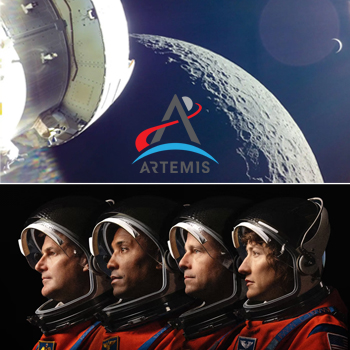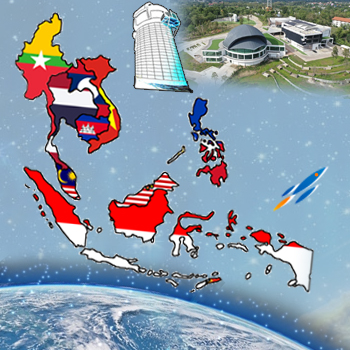NASA Moon Exploration Program is Advancing a Year After Artemis 1 Launch Despite Obstacles
|
MONDAY☆ Nov 13 — International Space Station, ~415-km LEO: Expedition 70 seven-member crew working with cargo from Dragon CRS-29 including ILLUMA-T laser communication relay; performing EarthKam lens changes, EMU maintenance, and onboard water analyses. ☆ Nov 13 — Tiangong Space Station, ~390-km LEO: Shenzhou 17 three-member crew demonstrating internal robotic arm tasks; experiments returned from space via Shenzhou 16 begin research studies on Earth. Highlights… o NewSpace: Interstellar Glory advancing Hyperbola-3 reusable rocket following successful 178.42m hop / vertical landing of Hyperbola-2; Rocket Factory Augsburg to receive US$4.3M from UKSA in support of SaxaVord Spaceport launch; Astra Space restructuring debt; Virgin Galactic to lay off 18% of workforce. ☆ Solar System: Artemis imagery team working with ESA to test mirrorless Handheld Universal Lunar Camera for Moon exploration; upGREAT spectrometer readings taken on SOPHIA show first direct observation of atomic oxygen in Venus atmosphere; Satellite of asteroid Dinkinesh revealed to be a contact binary via images taken during Lucy flyby. ☆ Galaxy: Stellar system Kepler-385 being studied after discovery of 4 additional super-Earth exoplanets (7 total) in new Kepler catalog; Researchers hope to utilize Advanced LIGO, VIRGO and eventually Cosmic Explorer in search for gravitational waves associated with Supernova 1987A; 13.2B year old quasar behind galaxy Abell 2744 observed by JWST and Chandra observatories via gravitational lensing is oldest known black hole. o Global: ESA to hold US$80.4M competition to develop commercial cargo spacecraft to launch NET 2028; Iceland and the Netherlands are 30th and 31st signatories to Artemis Accords; Russia satellites Resurs P-3 and Cosmos 2562 being monitored by LeoLabs following unexpected maneuvers. ● USA: University of Nebraska-Lincoln launching Consortium of Space, Policy, Agriculture, Climate and Extreme Environment to study growing food for Moon & Mars; Rocket Lab plans 22 Electron launches in 2024 as Neutron development continues; DoD to purchase data from SES O3b constellation in MEO under 5-year, $270M deal. ● Hawai’i: TMT mirror segment cutting and polishing continues (92 of 492 complete) as Board of Land and Natural Resources considers permit challenge and federal environmental impact statement pending; Swinburne University of Technology to join W. M. Keck Observatory as first international scientific partner. |
 |
● = Terrestrial and… o = International terrestrial events
☾ = Moon activity ★ = Space and… ☆ = International space / astro events in Hawaii Standard Time unless noted. Add 10 hours to obtain UT (‘Universal Time’). |
Weekly Planet Watch – Evening Planets: Venus (E), Jupiter (E), Saturn (S), Uranus (E), Neptune (E).
Space Age Prospects in Southeast Asia: Thai Astronomy, Singapore Comms, Indonesia Launch Capability
|
★ NET Nov 13 — SpaceX, Launch Super Heavy / Starship Orbital Test Flight, Starbase, Boca Chica TX: Super Heavy and Starship (Booster 9, Ship 25) launch vehicle to attempt nearly 1 full orbit of Earth culminating with re-entry and splashdown in Pacific ~100 km NW offshore of Kauai; launch window opens 07:00 CST. ☾ Nov 13 — Cislunar Autonomous Positioning System Technology Operations and Navigation Experiment (CAPSTONE), Near-Rectilinear Halo Orbit / Cislunar Space: NASA 12-U CubeSat Capstone acting as pathfinder for planned International Lunar Gateway reaches its 1st full year / enters 2nd year at NRHO having launch June 28, 2022 via Rocket Lab Electron Rocket. ● Nov 13 — NASA, Online / Washington DC: Space Technology Mission Directorate (STMD) LIFT-1 Industry Forum. ● Nov 13 — Intuitive Machines, Online / Houston TX: Intuitive Machines Third Quarter 2023 Financial Results Conference Call; 08:30 EST. ● Nov 13 — Astra, Online / Alameda CA: Astra Third Quarter 2023 Financial Results Update and Conference Call; 13:30 PST. o Nov 13-17 — International Astronomical Union, Addis Ababa, Ethiopia: IAU Symposium 386: Dark sky and Astronomical Heritage in Boosting Astro-Tourism Around the Globe. o Nov 13-17 — Edge Technologies, Tarsus Aerospace, UAE Space Agency, Dubai Civil Aviation Authority, et al, Dubai, United Arab Emirates: Dubai Airshow 2023. ☾ Nov 13 — Moon: 2.36° SSW of Mars, 03:00. Ongoing… ☾ Sep 6 – NET Jan/March — Smart Lander for Investigating Moon (SLIM), Lunar Landing Trajectory: SLIM Moon mission 4-6 month trajectory to soft land east of Shioli crater (13.2°S, 25.2°E) on Moon near side equatorial region. ☆ Sep 6 – NET Mar — X-Ray Imaging and Spectroscopy Mission (XRISM), ~550-km LEO: XRISM undergoing 6 month check out testing phase before start of science operations to study galactic plasma. ● Nov 11-17 — Asia-Pacific Economic Cooperation (APEC), et al, San Francisco CA: APEC Economic Leaders’ Week: Creating a Resilient and Sustainable Future for All. ● Nov 12-13 — Kitt Peak National Observatory,Tucson AZ: Overnight Telescope Observing Program; visitors use one of four Visitor Center telescopes. TUESDAYo Nov 14-16 — Space Tech Expo, SmarterShows, Bremen, Germany: Space Tech Expo Europe. |
● Nov 14-16 — NASA, Washington DC: 3rd Near Earth Object Workshop to Assess Reconnaissance for Planetary defense (NEO WARP 3).
● Nov 14-16 — National Academies of Sciences, Engineering, and Medicine, Washington DC: 187th Meeting of the Space Studies Board (SSB).
● Nov 14-18 — American Society for Gravitational and Space Research (ASGSR), Washington DC: ASGSR Annual Meeting 2023.
☾ Nov 14 — Moon: 1.65° S of Mercury, 05:00; with Mercury and Antares within circle of diameter 4.17°, 11:00; 0.88° NNE of Antares; 11:00.
☆ Nov 14 — Amor Asteroid 2021 UX6: Near-Earth Flyby (0.085 AU).
WEDNESDAY
● Nov 15 — International Lunar Observatory Association (ILOA Hawai’i), Kamuela HI: Galaxy Forum Hawaii 2023 Kamuela; at Anna Ranch, free, RSVP, 15:30-17:30.
● Nov 15 — Atlantic Council, SAAB, Space News, Washington DC: A conversation with General Chance Saltzman on maintaining competitive endurance in space; 13:30-14:20.
o Nov 15-17 — JAXA, ISAS, Sagamihara, Japan and Online: Hayabusa 2023: 10th Symposium of Solar System Materials.
☆ Nov 15 — Apollo Asteroid 2023 UO: Near-Earth Flyby (0.016 AU).
THURSDAY
☾ Nov 16 — Artemis 1 1st Observation, USA / Global: As USA and its international partners work toward Artemis 2 crewed mission around the Moon NET 2024, Space Launch System and Artemis 1 mission is observed today for its successful uncrewed flight Nov 16 – Dec 11, 2022.
● Nov 16 — Washington Space Business Roundtable (WSBR), Washington DC: WSBR Luncheon with Phil McAlister of NASA.
☆ Nov 16 — Mercury: 2.53° NNE of Antares, 17:00.
FRIDAY
☆ Nov 17 — Leonid Shower Peak: Appearing to radiate from constellation Leo, Leonids are associated with the comet Tempel–Tuttle; can produce 10 to 15 meteors per hour; peak 14:00.
☆ Nov 17 — Mars: At conjunction with Sun, 2.526 AU from Earth, 20:00.
☆ Nov 17 — Amor Asteroid 2023 UC11: Near-Earth Flyby (0.071 AU).
SATURDAY
● Nov 18 — AIAA LA-LV Section, Los Angeles CA: The Future of U.S. Robotic Planetary Exploration; 10:30-13:30.
● Nov 18 — Astronaut Scholarship Foundation, Kennedy Space Center, Titusville FL: Breakfast with Astronaut Nicole Stott; 10:00-11:30 EST.
☆ Nov 18 — Aten Asteroid 2019 LB1: Near-Earth Flyby (0.040 AU).
SUNDAY
☆ Nov 19 — Apollo Asteroid 2016 DK1: Near-Earth Flyby (0.013 AU).
☆ Nov 19 — Aten Asteroid 2022 VR1: Near-Earth Flyby (0.020 AU).

